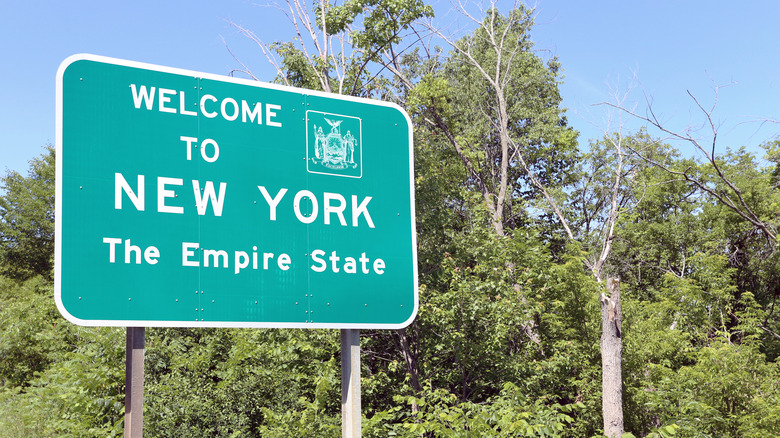If You Have $250,000 In Retirement Savings, Here's How Long You Could Live In New York
New York offers some really nice perks for those who wish to retire there. For instance, New York state and nearby New Jersey have some of the best hospitals in the country, ranking highly in Statista's 2025 list of the Best-in-State hospitals. You also get to live in the second most walkable, public transport-friendly city in the U.S. (per Walk Score) and not worry about expensive and psychologically taxing car maintenance. And, of course, all of this comes in a culturally rich, recreationally diverse package that could be very fulfilling for adventurous retirees.
The problem, however, is that a modest retirement savings figure won't last you very long. Contrary to popular belief, New York isn't the most expensive state in the country; that rank belongs to Hawaii, according to the World Population Review's 2025 report. New York didn't even make the top five most expensive states to live in, coming in sixth with a cost of living index of 123.3, about 64 points shy of Hawaii's high score. That said, it's still costly, and an anticipated yearly expenditure of $73,140 makes New York an expensive place to retire on such relatively modest savings. If you run the numbers, you'll discover that's enough to last about three and a half years or about five years if you add social security. Using the Economic Policy Institute family budget calculator, you'll discover that the average cost of living for a retired couple in New York City (NYC) is $92,899 per year, which means savings at that level will last even less, going only two to three years without other income.
The real price of retiring in New York
Housing is the single biggest factor that makes New York a challenge for retirees, since rent alone can eat up half of a modest retirement budget. According to Zillow, the average rent in New York City is about $3,700, almost $1,700 more than the national average of $2,050, and it is also the most expensive city for one-bedroom apartments. Even the affordable upstate cities in New York state, like Albany and Rochester, average $1,575 and $1,463. Homeowners aren't completely exempt either, because property taxes are among the top 10 most expensive among the U.S. states, according to the New York State Department of Taxation and Finance. However, senior retirees can take advantage of some property tax exemptions if they qualify.
Moving on to other bills and expenses, the cost of groceries and utilities also run above the national average. RentCafe's cost of living calculator, based on the Cost of Living Index published by the Council for Community and Economic Research, pins utilities at 13% higher than the national average. Healthcare by that same metric runs at 16% above the national average, which is a steep climb, despite being offset by world-class hospitals — especially when you consider that seniors 65 and over spent $8,000 on healthcare alone in 2023, per data from the Federal Reserve Bank of St.Louis.
In summary, all of this means that you need well over $1 million in savings to retire comfortably in New York. With the $93,000 annual expenditure estimate for a retired couple in NYC without social security, you would need nearly $1.9 million there over a 20-year retirement, and that's before accounting for inflation.
Where can you retire with $250,000?
If you're flexible on location, $250,000 stretches far longer in low-cost states — especially across the South and Midwest. Using GOBankingRates's September 2025 state-by-state "comfortable retirement" budgets, the cheapest five are West Virginia, Mississippi, Arkansas, Louisiana, and Oklahoma — all of which qualify as the cheapest states in the U.S. to retire. Their estimated annual out-of-pocket "comfortable" cost without Social Security runs about $37,600 to $40,500, meaning $250,000 would cover roughly six to seven years.
With Social Security, the cushion improves dramatically: GoBankingRates assumes a married couple benefit of $35,532 per year, dropping the "with Social Security" annual out-of-pocket in those same states to a range between $2,032 and $4,976, which implies your savings could last decades if spending matches those levels. For additional cross-checks on low-price states, the Bureau of Economic Analysis shows the lowest Regional Price Parities in some of those states were well below the U.S. average in 2023: Arkansas is 86.5, Mississippi is 87.3, and South Dakota is 88.1, meaning that they have roughly 10% cheaper day-to-day prices.
On the income side, the Social Security Administration reports the average retired-worker benefit is near $2,008 per month ($24,096 per year) in August 2025, which is helpful for modeling years-of-coverage with and without benefits. To see how this plays out in real housing budgets, you should look at the rent in value metros, which are all far below New York City. For example, Little Rock, Arkansas averages around $1,220, Tulsa, Oklahoma averages $1,350, and Jackson, Mississippi averages around $1,200 (via Zillow). Social Security could probably comfortably cover rent, which is usually where retirement savings live or die.


